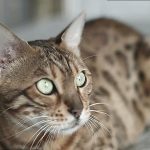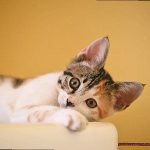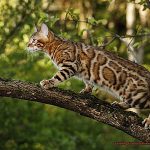It’s that time of year again when the air is filled with the sweet aroma of pine and twinkling lights adorn every corner.
As humans, we celebrate the holidays by adorning our homes with a well-decorated Christmas tree. But for our curious feline friends, it’s a whole different story.
For some reason, cats simply cannot resist the allure of a Christmas tree and always find a way to sneak their way into the midst of all the festive decorations. As an expert in all things feline, I’m here to shed some light on this mystery.
In this post, we’ll explore why cats are so drawn to Christmas trees.
We’ll delve into how their playful behavior, natural instincts to hunt and climb, and unique perception of their environment all play a role in their fascination with these seasonal symbols.
Curiosity
First, cats are naturally curious creatures. They love exploring new things and investigating their surroundings.
So when you bring a Christmas tree into your home, it’s like a brand-new playground for your kitty. The shiny ornaments, twinkling lights, and fresh scent of pine needles are all irresistible to their inquisitive nature.
But it’s not just curiosity that drives cats towards Christmas trees. They also see them as a prime opportunity for play.
The dangling ornaments make for perfect toys to bat around and watch swing back and forth. And let’s not forget about the lights – cats are often mesmerized by the twinkling bulbs and changing colors, providing endless entertainment for our feline friends.
In addition, cats’ hunting instincts may also be triggered by the movements of the branches and ornaments on the tree. The tree becomes an exciting hunting ground for them to stalk and pounce on their “prey”.
However, as much as we adore seeing our cats frolic among the branches of our Christmas trees, it’s important to take precautions to keep both them and our decorations safe. Cats may climb the tree, knock it over or even ingest tinsel or other decorations, which can lead to serious health issues.
Playfulness
They are naturally curious and love to explore the world around them, especially things that are visually captivating.
That’s why it’s no wonder that many cats find themselves irresistibly drawn to the enchanting allure of Christmas trees. With their twinkling lights, sparkling ornaments, and dangling tinsel, Christmas trees offer endless entertainment for our furry friends.
They provide the perfect playground for cats to climb, perch, and play around. You may catch your cat leaping from branch to branch, swatting at the ornaments, or even attempting to scale to the very top of the tree.
But while this playful behavior can be endearing, it does come with potential hazards. A curious cat knocking down fragile or breakable ornaments can pose a danger to both themselves and others around them.
That’s why it’s crucial to secure your Christmas tree properly and avoid using any delicate ornaments that could harm your cat if they were knocked down. Providing alternative toys and play areas can also help redirect your cat’s attention away from the tree and towards safe play.
Scent
When it comes to Christmas trees, the scent can be both alluring and stressful for them.
The piney aroma of the tree is naturally appealing to cats, especially if it’s freshly cut. It can also remind them of being outdoors, making their indoor surroundings more comforting.
But it’s not just the tree itself that draws cats in. The various decorations and ornaments hung on the tree can also pique their curiosity.
Many ornaments are made of materials like fabric or felt that can absorb and hold onto scents for long periods of time. Some may even have acquired musty or moldy odors from storage in attics or basements, which can be particularly enticing to our feline friends.
However, it’s important to keep in mind that cats use scent marking as a way to establish their territory. A new smell in the home, such as the scent of a Christmas tree, can disrupt their established boundaries and lead to territorial issues between cats or other animals in multi-animal households.
This can cause stress and tension between animals, which is why it’s crucial to monitor their behavior and provide them with plenty of space and resources. To ensure your furry friends’ safety and well-being during the holiday season, we recommend keeping fragile or potentially harmful ornaments out of reach.
Attention Seeking Behavior
One reason is that Christmas trees provide an elevated perch for cats to observe their surroundings. As we all know, cats love high places, and a Christmas tree can provide them with the perfect vantage point to watch the world go by.
The lights and decorations on the tree can also stimulate a cat’s senses and provide them with mental stimulation. Another reason why cats may be drawn to Christmas trees is that they enjoy playing with ornaments and other decorations.
The movement and sounds of ornaments can be very attractive to cats, making it impossible for them to resist the urge to play with them. However, this can lead to broken ornaments and potential danger if a cat ingests any of the decorations.
Lastly, cats may be drawn to Christmas trees simply because they crave attention from their owners. A cat may see their owner’s attention focused on the tree and want to be a part of it.
Climbing on the tree or knocking off ornaments can be a way for a cat to get their owner’s attention, even if it is negative attention. While it can be frustrating for owners, it is important to remember that attention-seeking behavior is natural for cats.
Instead of scolding or punishing your cat, try redirecting their focus with appropriate toys and playtime. Providing your cat with alternative sources of entertainment can help prevent them from becoming fixated on the Christmas tree.
Safety Precautions
The holiday season is a special time to spend with loved ones, including our furry friends.
However, as a cat owner, you may be concerned about your pet’s safety around your Christmas tree. Luckily, with some easy safety precautions, you can enjoy the festive atmosphere without putting your cat at risk.
Firstly, make sure your Christmas tree is anchored to a steady base such as a tree stand. This will prevent it from falling over if your curious kitty decides to take a climb.
To ensure extra stability, consider using fishing line or wire to anchor the tree to the wall. Secondly, be careful about the decorations you choose for your tree.
Tinsel may look like a dazzling addition to your holiday decor, but it can pose a danger to cats if ingested. It can cause intestinal blockages that could require surgery.
Also, certain types of Christmas lights may produce excessive heat or contain chemicals that are harmful if chewed on. So it’s better to avoid these decorations and opt for pet-safe alternatives.
Finally, supervise your cat when they’re in the same room as the tree. This will help prevent any accidents or mischievous behavior that could occur if left unsupervised.
Conclusion
In conclusion, it’s no surprise that cats and Christmas trees have become synonymous with the holiday season.
As we’ve discovered, our feline friends are naturally drawn to these festive decorations for a variety of reasons. Their inquisitive nature and playful behavior make them curious about anything new in their environment, while their unique sense of smell allows them to detect the fresh pine scent from afar.
But let’s not forget about their attention-seeking tendencies. Cats love nothing more than being the center of attention, and what better way to do so than by climbing up a towering tree adorned with shiny baubles?
However, it’s important to remember that safety should always come first when it comes to our pets.
By taking a few simple precautions such as securing the tree properly, avoiding fragile ornaments that could harm our furry companions if broken or ingested, and supervising them when they’re in the same room as the tree, we can ensure a happy and healthy holiday season for all.







